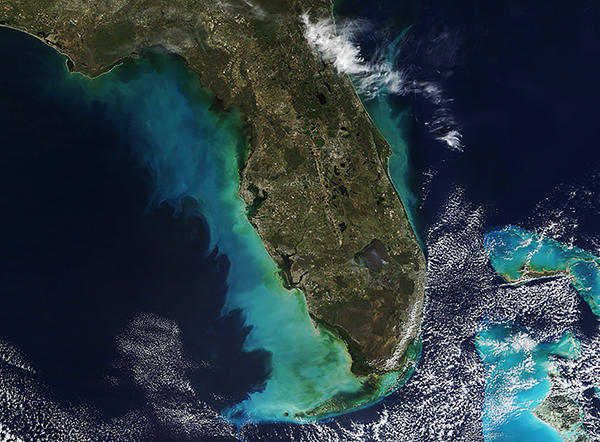Images
February 17, 2023 - Colors off the Coast of Florida
Tweet
Jewel-toned waters created a bright halo around much of Florida on February 14, 2023, when the Moderate Resolution Imaging Spectroradiometer (MODIS) on board NASA’s Terra satellite acquired a true-color image of the region.
Most of the radiant blues and greens can be seen floating in the Gulf of Mexico off of Florida’s western coast, part of a swatch stretching from Apalachicola on the Florida Panhandle to Florida Bay. Florida Bay sits between the Everglades and the Keys at the western tip of the state. A band of slightly duller tones also colors the Atlantic Ocean between Jacksonville (north) and Fort Pierce (south). Bright peacock blue in the southeast section of the image surrounds the Bahamas.
While the color surrounding the Bahamas are a daily occurrence caused by the shallowness of the underwater banks surrounding the islands, the colors in the Gulf of Mexico and Atlantic are more unusual. They are almost certainly primarily caused by sediment pouring off the land or stirred up by waves over the relatively shallow water of the West Florida Shelf after a strong mid- to upper-level cyclone passed over the state on February 12. Sediment appears tan as it floats at the surface of water, but changes color as it sinks, first to green and then to blue.
Phytoplankton, microscopic plant-like organisms, are also likely contributing a little color. These algae-like organisms live in the waters in this location year-round, and when conditions are favorable can reproduce explosively to cause large, colorful, blooms that are easily seen from space. Sediment carries nutrients, which creates a favorable environment for phytoplankton growth.
One notable type of phytoplankton is an organism called Karenia brevis, which is the cause of “red tide”. As it grows and spreads, K. brevis can release a toxin, or rather a cocktail of toxins, called “brevotoxins”. At very low levels, the organism is harmless, but in high concentrations a bloom of red tide can be deadly, especially to fish, dolphin, sea turtles, and manatees. It can cause respiratory and immune problems in people, and when people eat shellfish that have consumed K. brevis, it can make people quite sick.
Red tide has been reported along parts of the West Coast of Florida during much of February. According to the Florida Fish and Wildlife Conservation Commission, during the past week K. brevis was detected in 135 samples from and offshore of Southwest Florida and one from Northwest Florida. High levels (greater than 100,000 cells per liter of water) were detected in 58 samples from Southwest Florida, including Manatee County, Sarasota County, Charlotte County, and offshore of Lee County.
Image Facts
Satellite:
Terra
Date Acquired: 2/14/2023
Resolutions:
1km (721.3 KB), 500m (1.8 MB), 250m (3.8 MB)
Bands Used: 1,4,3
Image Credit:
MODIS Land Rapid Response Team, NASA GSFC
Tweet
Jewel-toned waters created a bright halo around much of Florida on February 14, 2023, when the Moderate Resolution Imaging Spectroradiometer (MODIS) on board NASA’s Terra satellite acquired a true-color image of the region.
Most of the radiant blues and greens can be seen floating in the Gulf of Mexico off of Florida’s western coast, part of a swatch stretching from Apalachicola on the Florida Panhandle to Florida Bay. Florida Bay sits between the Everglades and the Keys at the western tip of the state. A band of slightly duller tones also colors the Atlantic Ocean between Jacksonville (north) and Fort Pierce (south). Bright peacock blue in the southeast section of the image surrounds the Bahamas.
While the color surrounding the Bahamas are a daily occurrence caused by the shallowness of the underwater banks surrounding the islands, the colors in the Gulf of Mexico and Atlantic are more unusual. They are almost certainly primarily caused by sediment pouring off the land or stirred up by waves over the relatively shallow water of the West Florida Shelf after a strong mid- to upper-level cyclone passed over the state on February 12. Sediment appears tan as it floats at the surface of water, but changes color as it sinks, first to green and then to blue.
Phytoplankton, microscopic plant-like organisms, are also likely contributing a little color. These algae-like organisms live in the waters in this location year-round, and when conditions are favorable can reproduce explosively to cause large, colorful, blooms that are easily seen from space. Sediment carries nutrients, which creates a favorable environment for phytoplankton growth.
One notable type of phytoplankton is an organism called Karenia brevis, which is the cause of “red tide”. As it grows and spreads, K. brevis can release a toxin, or rather a cocktail of toxins, called “brevotoxins”. At very low levels, the organism is harmless, but in high concentrations a bloom of red tide can be deadly, especially to fish, dolphin, sea turtles, and manatees. It can cause respiratory and immune problems in people, and when people eat shellfish that have consumed K. brevis, it can make people quite sick. Red tide has been reported along parts of the West Coast of Florida during much of February. According to the Florida Fish and Wildlife Conservation Commission, during the past week K. brevis was detected in 135 samples from and offshore of Southwest Florida and one from Northwest Florida. High levels (greater than 100,000 cells per liter of water) were detected in 58 samples from Southwest Florida, including Manatee County, Sarasota County, Charlotte County, and offshore of Lee County.
Image Facts
Satellite:
Terra
Date Acquired: 2/14/2023
Resolutions:
1km (721.3 KB), 500m (1.8 MB), 250m (3.8 MB)
Bands Used: 1,4,3
Image Credit:
MODIS Land Rapid Response Team, NASA GSFC




